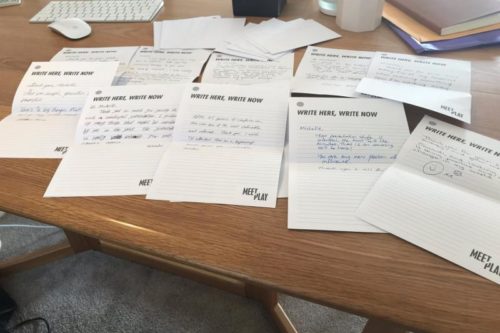Let me tell you a story…
His name was Sampson. Despite an obscure upbringing on the prairies of Illinois he wanted to make a difference on the national stage. But over and over again he failed. His business failed leaving him with nothing. He tried to go into politics aspiring to be the ‘Clinton of Illinois’ and lost election after election after election. He was skinny and awkward and ineffectual in debates.
Finally, after winning the election that mattered to him most, he found himself in the midst of a crisis. So he turned up at a gathering and gave an unexpected speech. He wanted to use his speech to exert his influence. But the odds weren’t great.
There were no TV cameras present and definitely no social media. The speaker before him – renowned for his confidence, passion and eloquence – kept the audience spellbound for almost two hours and sat down to rapturous applause. In contrast, Sampson finished his speech only to be met by silence. He thought he had bombed.
This speech is now known as The Gettysburg Address.
Its impact at the time was profound and it has become the most celebrated and memorable speech in American history. Sampson may have been his pen name, but his real name – the name we remember him for – is Abraham Lincoln. He wanted to become like Senator DeWitt Clinton. He became so much more. In the midst of the civil war and the fight against slavery, President Lincoln crafted a message that inspired a broken nation and echoes with poignant meaning to this day.
Now that is influence!
Why?
Why is this speech widely regarded as one of the greatest speeches ever delivered in the western world? The broader context and timing of the speech is definitely relevant, but I think there are 3 things about the speech itself that we can all implement in our communication immediately to have greater influence as leaders, sales people, presenters and professionals.
1) Brevity
I get it. Brevity is good. Surely you don’t want to risk being too brief though!
Put it this way: the Gettysburg Address consisted of only 10 sentences and 272 words. That is barely more than 1 minute! When was the last time you saw a speech of consequence last less than 2 minutes?
When John F Kennedy was preparing for his inaugural address as President in 1961, he instructed his speech writer Ted Sorensen to study all of the greatest speeches in history. After studying the Gettysburg Address they decided that brevity was a must. JFK’s address was one of the shortest inaugural addresses in US history, but arguably the greatest. “Ask not what your country can do for you, ask what you can do for your country.” Ring any bells?
By the way, the longest inaugural address was delivered by William Henry Harrison in 1841. He delivered his 1 hour 45 minute oration without wearing a hat or coat in a howling snowstorm, came down with pneumonia, and died one month later.
Ouch. I think you get the point!
Warning: next time someone says ‘I’ll only speak for five minutes’ do NOT believe them! No one in the corporate world EVER speaks for only five minutes. I know. I spend my life keeping other speakers at conferences to time! Be the exception. Please!
The less you say, the more people remember.
2) Preparation
“If I had more time, I would have written a shorter letter.”
This quote has been attributed to Mark Twain as well as George Bernard Shaw, Voltaire, Blaise Pascal, Johann Wolfgang von Goethe, Winston Churchill, Cicero, Bill Clinton, and Benjamin Franklin. Basically, anyone worth listening to!
It is easy to rabbit on. Brevity requires preparation. By all accounts Lincoln spent a ridiculous amount of time preparing and refining the 272 words of the Gettysburg Address. More time than you spent writing your wedding speech and definitely more time than that Powerpoint presentation you gave for the marketing team two weeks ago!
If you don’t have time to prepare like Lincoln, at the very least know your opening sentence and your closing sentence. Rehearse them. Get them nailed. Due to the rules of ‘primacy’ and ‘ recency’ people remember the first thing you say (primacy) and the last thing you say (most recent). Make them count.
If you fail to prepare, prepare to fail
3) Story
We know stories are powerful. In my last blog post I shared how to tell your personal story in a compelling way (read it here – it’s worth it). Lincoln too recognised the power of story.
He begins: “Four score and seven years ago our fathers brought forth on this continent, a new nation, conceived in Liberty, and dedicated to the proposition that all men are created equal.”
Does this opening sound familiar? It should:
How does a Disney story begin? “Once upon a time…”
How does the Star Wars story begin? “A long time ago in a galaxy far, far away…”
How does Lincoln begin? “Four score and seven years ago…”
This is how Lincoln influenced a nation. Lincoln’s speech was actually a story. To the untrained eye it may not appear to be a story, but it was the elements of story that made his message truly connect.
I’ve spoken at and facilitated hundreds of corporate conferences, and seen hundreds of presentations, and very few use story. Fact.
Make your message connect. Tell a story.
For more on how to tell a compelling story check out my previous blog post here.
Call to action
Next time you have a message to share that really matters, take a leaf out of Lincoln’s playbook. Whether it is a presentation, a meeting, a phone call, or simply a conversation, remember:
The less you say, the more people remember.
If you fail to prepare, prepare to fail.
Make your message connect. Tell a story.
It worked for Lincoln. It can work for you!
If you found this valuable please share it with someone you respect. And please leave a comment or send me an email if you’d like to share your thoughts. I’d love to hear from you.
IF YOU WANT EASY ACCESS TO MORE BLOG POSTS AND OTHER SPECIAL TIPS ON BECOMING PEOPLE OF INFLUENCE JOIN OUR MAILING LIST (DETAILS TO THE RIGHT).
Want more? Learn more about storytelling, presence and persuasion, and presentation skills in our leadership development virtual programs and team offsites sections.




